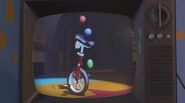Red's Dream is a 1987 computer-animated short film produced by Pixar Animation Studios.
Plot[]
On a rainy night in the city, Red, a unicycle sitting in the clearance corner of a bike shop, begins to dream.
Inside its dream, it is being ridden by a clown named Lumpy. After arriving to meager applause, Lumpy begins to juggle three balls. However, Lumpy occasionally drops them, prompting Red to bounce them back up, much to Lumpy's confusion. Suddenly, Lumpy accidentally flings one ball too far, causing Red to dismount from under Lumpy catch the ball itself. Lumpy doesn't realize this, as he's now pedaling in mid-air, while Red watches him. Eventually, Lumpy realizes the unicycle is no longer under him, causing him to fall, to which Red begins to juggle all three balls. Upon finishing its performance, Red receives uproarious applause from the entire audience, to which it starts bowing to.
Unfortunately, it's at this point that Red wakes up from its dream. Realizing its fame and admiration was not real, Red sadly heads back to the clearance corner and falls back asleep.
Production[]
According to John Lasseter, Ed Catmull wanted the Pixar staff to make a film using the Pixar Image Computer and the rendering software Chapreyes. Lasseter began to develop the story of a circus clown who is upstaged by his own unicycle while at the same time, animators William Reeves and Eben Ostby started working on their own separate ideas. Ostby had wanted to animate a bicycle, and Reeves began working on a city during a rainy night. Ultimately, the three combined their ideas, which resulted in the creation of Red's Dream.
Controversy[]
In 1994, Pixar sued video game production company DMA Design for their game, Uniracers, for the Super Nintendo Entertainment System, because of how the unicycles in the game bore a strong resemblance to the unicycle in Red's Dream. Pixar argued that they were the owners of the unicycle model, and the judge ended up ruling in favor of Pixar, prompting Nintendo to permanently stop production of game cartridges for Uniracers. As a result of the lawsuit, only 300,000 cartridges of the game ended up being made.
Trivia[]
- On the wall near the Clearance Section, a clock can be seen with a picture of André from the short The Adventures of André & Wally B.
- Towards the end, after Red has its dream, a Luxo lamp is visible to the left of the Andre clock.
- The floor on the circus ring during the dream is a texture of a ball from Luxo, Jr.
- This is the only Pixar short that was never released with a Pixar film, thus making it only available on compilation home video releases (see above).
- The name of the bike shop where the short takes place, Eben's Bikes, is named after veteran Pixar animator, Eben Ostby.
- There is a message written at the end of the credits that reads, "All characters and events are fictitious. Any resemblance to actual persons and appliances, living or dead, is purely coincidental. The FBI investigates crimes. Mark Leather wrote a paint system but his name is really here just to impress girls. No portion of this movie, including the soundtrack, may be reproduced in any manner. Pixar, Reyes, ChapReyes and Pixar Image Computer are trademarks of Pixar. Always wear a helmet."
- Red and Lumpy appear in a cameo in Toy Story 2 on the television screen in Andy's room.
- Red is seen in WALL-E as part of WALL-E's collection, right after he is launched into the side of its home.
- When viewers first see inside the shop, opposite to the bikes is a poster from Bill Reeves and Alain Fournier's 1986 animation test, Flags and Waves.
- The name Red's Dream appears on a book in Toy Story.
- This is the only Pixar film that used the Pixar Image Computer for rendering. The computer was powerful enough to support the entire Reyes rendering system, so they had to trim down the software to only a few basic functions (called ChapReyes). Due to the limitations, only the dream sequence of the film is rendered on the Pixar Image Computer, and there is no motion blur.
- The short won Europe's top award for computer animation "The Prix Ars Electronica" in 1988.[1]
Gallery[]
References[]
- ↑ Amidi, Amid (2009). The Art of Pixar Short Films. San Francisco, CA: Chronicle Books LLC.





